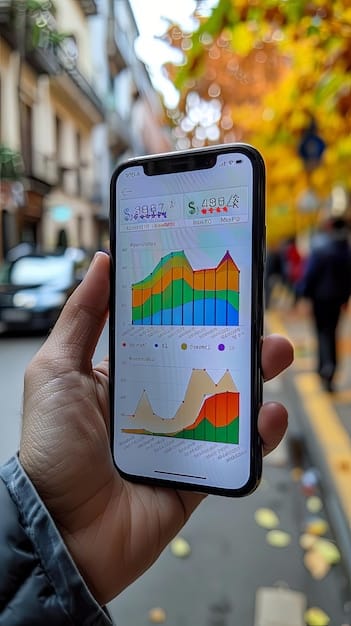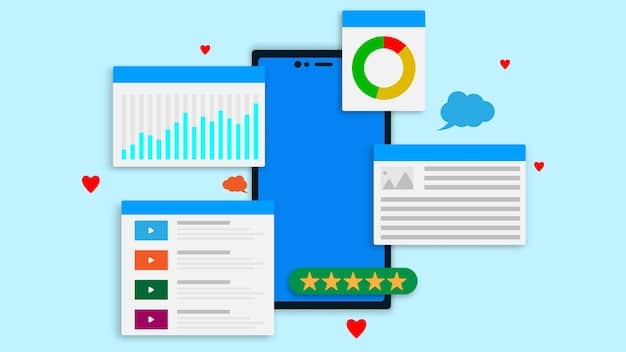Boost E-commerce Sales: Google Ads Strategies for 15% Conversion in 2025

How to Increase E-commerce Conversion Rates by 15% Using Updated Google Ads Strategies in 2025 involves a deep dive into leveraging AI-powered automation, optimizing for mobile-first experiences, and personalizing ad content to meet ever-changing consumer expectations, thus improving ROI and market competitiveness.
In the fast-paced world of e-commerce, staying ahead means constantly adapting your strategies. One of the most crucial aspects of success is optimizing your Google Ads campaigns to how to increase E-commerce Conversion Rates by 15% Using Updated Google Ads Strategies in 2025. As we approach 2025, the landscape of online advertising is set to evolve dramatically, driven by advancements in AI, changing consumer behaviors, and new advertising formats.
This article explores actionable strategies to help you harness the power of Google Ads and achieve a significant increase in your e-commerce conversion rates. By focusing on innovations like AI-driven personalization, hyper-targeted advertising, and enhanced measurement techniques, you can ensure your campaigns are not only seen but also drive meaningful results. We’ll provide useful tips to how to increase E-commerce Conversion Rates by 15% Using Updated Google Ads Strategies in 2025.
Understanding the Evolving Google Ads Landscape
The world of Google Ads is constantly changing. To achieve a 15% increase in e-commerce conversion rates by 2025, understanding these shifts is vital. This section explores the key trends and technologies reshaping Google Ads, preparing you to adapt and thrive.
The Rise of AI and Machine Learning in Google Ads
AI and machine learning are becoming increasingly integral to Google Ads. These technologies power automated bidding strategies, ad personalization, and audience targeting. As AI evolves, advertisers can expect more sophisticated tools that analyze vast datasets to predict user behavior and optimize campaigns in real-time.
Furthermore, AI-driven insights help identify high-potential keywords and ad creatives, leading to more efficient ad spend and higher conversion rates. Integrating these technologies into your Google Ads strategy is no longer optional; it’s a necessity for competitive e-commerce businesses.
- Leverage Smart Bidding: Utilize Google’s automated bidding options like Target CPA and Target ROAS to optimize bids in real-time.
- Personalize Ad Content: Use dynamic ad insertion to tailor ad copy and landing pages to individual user profiles.
- Adopt Predictive Analytics: Implement AI-powered tools to forecast campaign performance and identify future trends.

By embracing these AI-driven approaches, you can significantly improve the performance of your Google Ads campaigns. This is essential to how to increase E-commerce Conversion Rates by 15% Using Updated Google Ads Strategies in 2025.
Optimizing Mobile-First E-commerce Experiences
With the majority of online shopping now occurring on mobile devices, optimizing for mobile-first experiences is essential. Neglecting this area can lead to lower conversion rates and lost revenue. This section outlines how to create seamless mobile experiences that drive conversions.
Focusing on mobile speed, intuitive navigation, and mobile-specific ad formats can drastically improve user engagement and conversion rates. By prioritizing mobile optimization, e-commerce businesses can capitalize on the growing trend of mobile commerce and outpace competitors.
Enhancing Mobile Page Speed and User Experience
Mobile users expect fast loading times and seamless navigation. Slow loading pages and clunky interfaces can frustrate users, leading to high bounce rates and missed opportunities. Optimizing your mobile site for speed and usability is crucial.
- Compress Images: Reduce image file sizes without sacrificing quality to improve page load times.
- Simplify Navigation: Ensure your mobile site has clear, intuitive navigation that guides users effortlessly.
- Use Accelerated Mobile Pages (AMP): Implement AMP to deliver lightning-fast loading times for your product pages.
Leveraging Mobile-Specific Ad Formats
Google Ads offers a variety of mobile-specific ad formats designed to engage users on their devices. These formats include app install ads, click-to-call ads, and location-based ads. Leveraging these formats can significantly enhance your mobile advertising efforts.
By tailoring your ad creatives to the mobile context, you can provide a more relevant and compelling experience for potential customers. This is important to how to increase E-commerce Conversion Rates by 15% Using Updated Google Ads Strategies in 2025.

Implementing Enhanced Measurement Techniques
Accurate tracking and measurement are essential for optimizing Google Ads campaigns. This section explores the latest measurement techniques and tools that provide deeper insights into campaign performance and user behavior, helping you refine your strategies and achieve a 15% increase in e-commerce conversion rates by 2025.
Utilizing Enhanced Conversions for Accurate Tracking
Enhanced Conversions is a Google Ads feature that improves the accuracy of conversion tracking by sending hashed customer data from your website to Google. This helps bridge the gap created by privacy restrictions and cookie limitations, providing a more complete view of the customer journey.
By implementing Enhanced Conversions, you can better understand which ads and keywords are driving the most valuable conversions. This is a key aspect to how to increase E-commerce Conversion Rates by 15% Using Updated Google Ads Strategies in 2025.
Leveraging Attribution Modeling for Better Insights
Attribution modeling allows you to assign credit to different touchpoints in the customer journey. By understanding which interactions are most influential in driving conversions, you can optimize your ad spend and allocate resources more effectively.
- Explore Different Models: Experiment with various attribution models, such as data-driven, last-click, and time decay, to determine which provides the most accurate insights.
- Analyze Path Lengths: Identify the average number of interactions it takes for a customer to convert and optimize your campaigns accordingly.
- Refine Bidding Strategies: Adjust your bidding strategies based on the attribution model that best reflects the value of each touchpoint.
Personalizing the Ad Experience
Personalization is no longer just a marketing buzzword; it’s a critical strategy for driving conversions. By tailoring ad content and landing pages to individual user preferences, you can create a more engaging and relevant experience that resonates with potential customers.
Implementing personalized ad experiences leads to higher click-through rates, lower bounce rates, and increased conversion rates. This section explores techniques to achieve this.
Dynamic Ad Insertion for Personalized Messaging
Dynamic Ad Insertion (DAI) allows you to customize ad copy based on user search queries, demographics, and browsing history. This ensures that your ads are always relevant and tailored to the individual user’s needs and interests.
Creating Personalized Landing Pages
Personalized landing pages enhance the user experience by providing content that aligns with their specific interests and preferences. By tailoring the landing page to match the ad copy and user profile, you can increase engagement and drive more conversions.
By delivering personalized content, e-commerce businesses can build stronger connections with their audience and improve the overall customer experience. This is crucial to how to increase E-commerce Conversion Rates by 15% Using Updated Google Ads Strategies in 2025.
Adapting to Privacy Changes and Data Regulations
As privacy concerns grow and data regulations tighten, e-commerce businesses must adapt their Google Ads strategies to comply with new standards. This section explores how to navigate the changing privacy landscape while still effectively targeting and engaging potential customers.
By prioritizing user privacy and transparency, businesses can build trust with their audience and maintain effective advertising campaigns. This section delves into this further.
First-Party Data Strategies
With third-party cookies becoming less reliable, first-party data is more valuable than ever. Collecting and leveraging your own customer data can provide valuable insights into user behavior and preferences.
- Implement Customer Relationship Management (CRM): Utilize a CRM system to collect and manage customer data from various touchpoints.
- Offer Personalized Experiences: Use first-party data to tailor offers, recommendations, and content to individual customers.
- Maintain Transparency: Clearly communicate your data collection practices to users and provide options for data control.
The increasing focus on data privacy requires e-commerce businesses to adapt and innovate. By prioritizing user privacy and leveraging first-party data, these companies can build enduring relationships with their customers and maintain effective advertising campaigns. Properly managing user’s data will help how to increase E-commerce Conversion Rates by 15% Using Updated Google Ads Strategies in 2025.
In conclusion, achieving a 15% increase in e-commerce conversion rates through Google Ads in 2025 requires a comprehensive strategy that embraces AI, prioritizes mobile experiences, enhances measurement techniques, personalizes ad content, and respects user privacy. By staying ahead of the curve and adapting to these trends, e-commerce businesses can unlock new opportunities and drive significant growth.
| Key Point | Brief Description |
|---|---|
| 🤖 AI Automation | Use AI for dynamic bidding and ad personalization. |
| 📱 Mobile-First | Optimize mobile page speed and ad formats for user experience. |
| 📊 Enhanced Tracking | Implement Enhanced Conversions for accurate tracking. |
| 🔒 Data Privacy | Prioritize first-party data and transparency. |
Frequently Asked Questions
Key AI strategies include leveraging smart bidding, personalizing ad content with dynamic ad insertion, and adopting predictive analytics to forecast campaign performance and optimize ad spend.
Mobile optimization is crucial because the majority of online shopping now occurs on mobile devices. A slow, clunky mobile experience can lead to high bounce rates and lost sales opportunities.
Enhanced Conversions improve tracking accuracy by sending hashed customer data from your website to Google, bridging the gap caused by privacy restrictions and cookie limitations to offer a more complete conversion view.
Attribution modeling assigns credit to different touchpoints in the customer journey, helping you understand which interactions are most influential in driving conversions and optimize your ad spend accordingly.
Adapt by prioritizing first-party data collection and usage, maintaining transparency with users about data practices, and offering options for data control to build trust and maintain effective campaigns.
Conclusion
Mastering Google Ads strategies to how to increase E-commerce Conversion Rates by 15% Using Updated Google Ads Strategies in 2025 requires continuous adaptation and a deep understanding of emerging trends. By focusing on AI-driven automation, mobile optimization, enhanced measurement, personalization, and data privacy, e-commerce businesses can stay ahead of the curve and drive significant growth.
Embracing these strategies will not only improve your conversion rates but also enhance the overall customer experience, fostering long-term loyalty and success in the competitive e-commerce landscape.





